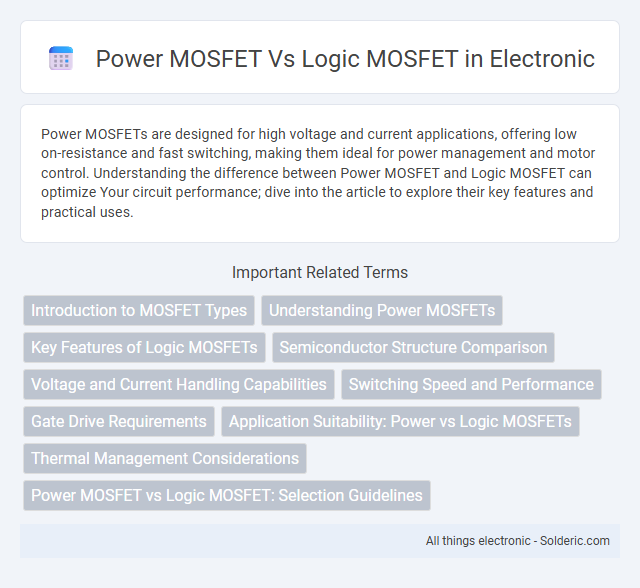Power MOSFETs are designed for high voltage and current applications, offering low on-resistance and fast switching, making them ideal for power management and motor control. Understanding the difference between Power MOSFET and Logic MOSFET can optimize Your circuit performance; dive into the article to explore their key features and practical uses.
Comparison Table
| Feature | Power MOSFET | Logic MOSFET |
|---|---|---|
| Purpose | High current switching, power management | Low-voltage digital logic applications |
| Gate Threshold Voltage (Vth) | Higher (typically 2-4V) | Lower (typically 1-2.5V) |
| On-Resistance (Rds(on)) | Low, optimized for minimal power loss | Higher compared to Power MOSFET |
| Voltage Ratings | Typically 20V to 1000V+ | Lower, often below 30V |
| Applications | Power supplies, motor drivers, DC-DC converters | Logic level switching in microcontroller circuits |
| Switching Speed | Moderate to high | High, optimized for fast logic switching |
| Drive Voltage | Usually requires 10-12V gate drive | Optimized for 3.3V or 5V logic level drive |
Introduction to MOSFET Types
Power MOSFETs are designed to handle high voltage and current applications, featuring low on-resistance and rapid switching capabilities to improve efficiency in power management systems. Logic MOSFETs, optimized for low voltage operation and small gate charge, are ideal for digital circuits where fast switching and low power consumption are critical. Understanding these key differences helps you select the right MOSFET type for your electronic design's performance and efficiency requirements.
Understanding Power MOSFETs
Power MOSFETs are specialized transistors designed to handle high voltage and current levels with low on-resistance, making them ideal for power switching applications in automotive, industrial, and consumer electronics. Their structure typically features a vertical design that enables efficient heat dissipation and high current capacity compared to Logic MOSFETs, which are optimized for low-voltage digital circuits with faster switching speeds and lower gate charge. Understanding Power MOSFETs involves recognizing their capability to manage significant power levels while maintaining energy efficiency and thermal stability in demanding environments.
Key Features of Logic MOSFETs
Logic MOSFETs feature low gate threshold voltages typically around 1.8V to 2.5V, enabling efficient operation with low-voltage digital circuits. Their optimized R_DS(on) values minimize conduction losses while maintaining fast switching speeds essential for high-frequency applications. Designed for compatibility with standard logic-level signals, Logic MOSFETs excel in battery-powered devices and microcontroller-based systems where power efficiency and quick response are critical.
Semiconductor Structure Comparison
Power MOSFETs feature a vertical structure with a thick epitaxial layer designed for high voltage and current handling, optimizing low on-resistance and fast switching. Logic MOSFETs utilize a lateral structure with thin gate oxide and shallow junctions to ensure low gate charge and rapid switching at low voltages typical of digital circuits. The structural differences directly impact their electrical characteristics, with power MOSFETs excelling in high-power applications and logic MOSFETs tailored for efficiency in integrated digital logic.
Voltage and Current Handling Capabilities
Power MOSFETs are designed to handle high voltages typically ranging from 20V to over 1000V and deliver high current levels, often exceeding tens of amperes, making them suitable for power management and switching applications. Logic MOSFETs operate at lower voltages, usually below 20V, and are optimized for low current loads with enhanced switching speeds in digital circuits. The key difference lies in the robust construction and lower on-resistance of Power MOSFETs that enable efficient handling of high power, whereas Logic MOSFETs prioritize gate threshold voltage compatibility for logic-level drive signals.
Switching Speed and Performance
Power MOSFETs typically offer higher switching speeds and better thermal performance, making them ideal for high-power, high-frequency applications such as motor drives and power supplies. Logic MOSFETs are optimized for low gate charge and minimal on-resistance at low voltages, which enhances switching efficiency in digital circuits and battery-operated devices. Your choice between Power and Logic MOSFETs should align with the specific speed and performance demands of your electronic design.
Gate Drive Requirements
Power MOSFETs require higher gate drive voltages, typically around 10-15V, to fully enhance the device and minimize R_DS(on) for efficient conduction. Logic MOSFETs are optimized for low-voltage gate drive signals, usually around 4.5-5V, enabling direct drive from standard logic-level outputs of microcontrollers and digital ICs. The gate charge and threshold voltage differences between Power and Logic MOSFETs directly impact switching speed and drive complexity in power management applications.
Application Suitability: Power vs Logic MOSFETs
Power MOSFETs are designed for high-current and high-voltage applications, making them ideal for power supplies, motor controls, and automotive systems where efficiency and heat dissipation are critical. Logic MOSFETs, optimized for low voltage and low current operations, suit digital circuits and microcontrollers, ensuring fast switching and low gate drive voltage. Your choice between these MOSFET types should align with the specific power handling and switching requirements of your electronic design.
Thermal Management Considerations
Power MOSFETs require advanced thermal management solutions due to higher current loads and increased heat dissipation, often utilizing heat sinks, thermal pads, and forced airflow to maintain reliable operation. Logic MOSFETs operate at lower power levels with minimal heat generation, enabling simpler cooling methods and often relying on PCB copper areas for passive heat dissipation. Effective thermal management in Power MOSFETs is crucial to prevent thermal runaway and ensure device longevity, while Logic MOSFETs typically maintain stable temperatures with standard PCB design techniques.
Power MOSFET vs Logic MOSFET: Selection Guidelines
Power MOSFETs are designed to handle high current and voltage, making them ideal for power management and switching applications, whereas Logic MOSFETs prioritize low gate threshold voltage and fast switching for digital circuits. Selection guidelines emphasize evaluating parameters like R_DS(on), gate charge, and voltage ratings; Power MOSFETs typically have higher R_DS(on) but are optimized for low conduction losses, while Logic MOSFETs feature lower gate-drive requirements for efficient logic-level operation. Engineers should choose Power MOSFETs for high-power, high-efficiency tasks and Logic MOSFETs for low-voltage digital control and signal processing applications.
Power MOSFET vs Logic MOSFET Infographic

 solderic.com
solderic.com